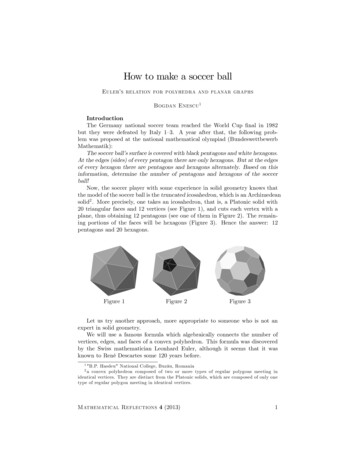
Transcription
How to make a soccer ballEuler’s relation for polyhedra and planar graphsBogdan Enescu1IntroductionThe Germany national soccer team reached the World Cup nal in 1982but they were defeated by Italy 1–3. A year after that, the following problem was proposed at the national mathematical olympiad (BundeswettbewerbMathematik):The soccer ball’s surface is covered with black pentagons and white hexagons.At the edges (sides) of every pentagon there are only hexagons. But at the edgesof every hexagon there are pentagons and hexagons alternately. Based on thisinformation, determine the number of pentagons and hexagons of the soccerball!Now, the soccer player with some experience in solid geometry knows thatthe model of the soccer ball is the truncated icosahedron, which is an Archimedeansolid2 . More precisely, one takes an icosahedron, that is, a Platonic solid with20 triangular faces and 12 vertices (see Figure 1), and cuts each vertex with aplane, thus obtaining 12 pentagons (see one of them in Figure 2). The remaining portions of the faces will be hexagons (Figure 3). Hence the answer: 12pentagons and 20 hexagons.Figure 1Figure 2Figure 3Let us try another approach, more appropriate to someone who is not anexpert in solid geometry.We will use a famous formula which algebraically connects the number ofvertices, edges, and faces of a convex polyhedron. This formula was discoveredby the Swiss mathematician Leonhard Euler, although it seems that it wasknown to René Descartes some 120 years before.1 "B.P.Hasdeu" National College, Buz¼a u, Romaniaconvex polyhedron composed of two or more types of regular polygons meeting inidentical vertices. They are distinct from the Platonic solids, which are composed of only onetype of regular polygon meeting in identical vertices.2aMathematical Reflections 4 (2013)1
On November 14, 1750, in a letter to his friend, the numbertheorist Christian Goldbach (1690–1764), Euler wrote, “It astonishesme that these general properties of solid geometry have not, as faras I know, been noticed by anyone else.”[2]Let V , E, and F denote the number of vertices, edges, and faces of a convexpolyhedron. Then the following equality holds:Euler’s relationVE F 2:Let us now return to the soccer ball. We will prove that the ball’s surface iscovered with 12 pentagons and 20 hexagons.Our rst proof is based on a concept de ned by R. Descartes: the angularde cit of a polyhedron’s vertex. This is de ned as the di erence between 360and the sum of all plane angles at that vertex. Intuitively, the angular de citmeasures how "pointy" is the respective vertex. For instance, in our case, theangular de cit is, at any vertex, 12 (see Figure 4).Figure 4Descartes obtained the following remarkable result:Theorem 1. The sum of the angular de cits of all the vertices of a closedconvex body is equal to 720 .Proof. Let Fk be the number of faces having k edges. Thus, we haveF F3 F4 F5 : : : :(clearly, only a nite number of the Fk ’s are nonzero). Also, counting edges byfaces, we obtain2E 3F3 4F4 5F5 : : :Since the sum of the interior angles on an n gon equals 180 (n 2) ; thesum of all interior angles of all the faces (equivalently, the sum of plane anglesat all vertices) equalsS 180 (3F3 4F4 : : :2 (F3 F4 : : :)) 180 (2EMathematical Reflections 4 (2013)2F ) :2
Therefore, the sum of all angular de cits is360 VS 360 V180 (2E2F ) 360 (VE F ) 720 ;as desiredIt is easy now to nish our problem. Since each vertex has a 12 angularde cit, we deduce that the number of vertices is 720 12 60: A pentagon isincident at each vertex, but every pentagon is counted 5 times. Hence, thenumber of pentagons is 60 5 12: Similarly, we have 120 6 20 hexagons.Looking at a golf ball we may notice the large number of hexagonal dimplesand, every now and then, a pentagonal one (Figure 5). If we count up the latter,we nd that there are once again 12 pentagonal faces. This is not by chance.Figure 5A second proof shows why this is happening. More precisely, we prove thefollowing statement.Theorem 2. If every face of a polyhedron is a pentagon or a hexagonand if the degree3 of every vertex is three, then the polyhedron has exactly 12pentagonal faces.Proof. Let P and H denote the number of pentagonal and hexagonal faces,respectively. Then we haveF P H;and, counting edges by faces,2E 5P 6H:Since every vertex has degree 3, counting edges by vertices yields2E 3V;3 thedegree of a vertex is the number of edges incident to that vertex.Mathematical Reflections 4 (2013)3
henceV 2E:3Plugging this in Euler’s relation gives2E3E F 2;or3FE 6;and it follows that6F2E 12:But6F2E 6 (P H)(5P 6H) P;hence P 12; as expectedPlanar graphsLet us begin by examining the following problem.There are n 2 points on a circle. Each pair of them is connected by a chordsuch that no three of them pass through the same point inside the circle. Findthe number of regions in which these chords divide the interior of the circle.n 2 r 2n 3 r 4n 4 r 8n 5 r 16n 6 r ?Figure 6If one examines gure 6, chances are that they are tempted to answer r 2n 1 ; since this holds for n 2; 3; 4; and 5: However, if we count the regions forthe case n 6; we might be surprised to observe that there are only 31 regions,and not 32; as suggested by the previous results.So, how many regions are there in the general case? To answer that, wewill need an equality, again named Euler’s relation, concerning planar graphsinstead of polyhedra.A graph G is a pair of sets (V; E) where V is a nonempty set whose elementsare called vertices, and E is a set of unordered pairs of elements of V; callededges. Intuitively, we represent the vertices as points in plane and edges as lineMathematical Reflections 4 (2013)4
segments or arcs joining some pairs among these points. In this article, we referonly to nite simple graphs, that is, graphs in which the number of vertices is nite and each edge joins at most one pair of distinct vertices.The degree of a vertex v, denoted by d (v), is the number of edges incidentto it. A simple double counting argument justi es the following result.(Handshaking Lemma) In any graphXd (v) 2 jEj ;v2Vwhere jEj is the number of graph’s edges.A sequence of distinct vertices v1 ; v2 ; : : : ; vk in which vi and vi 1 are connected by an edge (these are called adjacent vertices) for all i; is called a path.If v1 ; v2 ; : : : ; vk is a path and vk and v1 are also adjacent vertices, the sequenceis called a cycle of the graph.A graph is connected if any two vertices are the endpoints of some path.The same graph can be represented by di erent drawings in the plane. Forinstance, the two drawings in gure 7 represent the same graph G (V; E) :1253614572367884a)b)Figure 7Here we haveV f1; 2; 3; 4; 5; 6; 7; 8g ;andE ff1; 5g ; f1; 7g ; f2; 6g ; f2; 8g ; f3; 4g ; f3; 7g ; f4; 8g ; f5; 6gg :A graph G is planar if there exists a drawing of G in the plane in which notwo edges intersect in a point other than a vertex of G. A planar graph dividesthe plane into regions (bounded by edges) called faces, one of them being the"in nite" outer region.Mathematical Reflections 4 (2013)5
f1BCAEf3f2DIf4GHFFigure 8The graph in gure 8 is a planar graph with 9 vertices, 11 edges, and 4 faces(the face f1 is the outer region and it is bounded by edges AB; BC; CD; DE;EF; F G; GI; IH; and HB; the face f2 is a triangular face and it is bounded byedges BI; IH; and HB;etc.)For a planar graph we can de ne the degree of a face as the number ofencounters with edges in a walk round the boundary of that face. Examine gure 9; we have three regions: f (the outer in nite one), f 0 ; and f 00 :fff'f'f ''f ''d(f ') 4d(f) 7Figure 9It is easy to see that d (f ) 7 and d (f 0 ) 4: The reader is asked to verifythat d (f 00 ) 5: Observe that the graph in gure 9 has jEj 8; and that7 4 5 2 8:If we denote by F the set of faces of a planar graph G; an equality verysimilar to the handshaking lemma is easy to check.Theorem 3. In any planar graph GXd (f ) 2 jEj :f 2FNow, returning to convex polyhedra, observe that the vertices and edges of apolyhedron can be viewed as a graph, called a polyhedral graph. An importantMathematical Reflections 4 (2013)6
property of these graphs is that they are planar. Take any convex polyhedron;we can obtain a connected planar graph by choosing a face as base, stretching thebase su ciently large and taking a top view projection onto the plane containingthe base (see gure 10 for a cube). The regions of these planar representationsdirectly correspond to the faces of the polyhedra. One of these regions is the"in nite" outer region of the graph.Figure 10Another way of obtaining a planar graph corresponding to a given convexpolyhedron is by using a perspective projection of the polyhedron onto a planewith the center of perspective chosen near the center of one of the polyhedron’sfaces (see gure 11)Figure 11An interesting question is whether any planar graph is a polyhedral one.The answer is, of course, negative. One can easily see that a polyhedron graphcannot have vertices with the degree less than 3.Steinitz’s theorem (1922) is a characterization of the planar graphs formedby the edges and vertices of convex polyhedra: they are exactly the 3-connected4planar graphs. That is, every convex polyhedron forms a 3-connected planar4agraph is k-connected if removing any k-1 vertices yields a connected graph.Mathematical Reflections 4 (2013)7
graph, and every 3-connected planar graph can be represented as the graph ofa convex polyhedron.The Euler’s relation also holds for planar graphs. If G is a connected planargraph with v vertices, e edges, and f faces, thenve f 2:(Do not forget that one of the faces is the in nite outer one). We present aproof in the next paragraph.Let us return to the problem we proposed at the beginning of this paragraph,and let Rn be the wanted number of regions. If we remove the n arcs on thecircle (along with the n circular segment regions), we obtain a convex n-gon,which, together with its diagonals and their intersection points, de nes a simpleand connected planar graph (see gure 12). Let v; e; and f be the number ofvertices, edges, and faces of this graph. We haveRn f n1;since we removed the n circular regions, but we have to discard in our countingthe outer region of the graph.Euler’s relation givesv e f 2;so we have to determine v and e in terms of n:DBXACFigure 12We have v n i; where i is the number of vertices in the interior of then-gon. It is not di cult to see thati n4;since every interior intersection point is determined by a set of 4 distinct vertices of the n-gon (point X in gure 12 is completely determined by the setfA; B; C; Dg).Now, let us count the edges. A number of n 1 edges are incident to eachof the original n points and 4 edges are incident to every interior point (sinceMathematical Reflections 4 (2013)8
no three diagonals pass through the same point). Every edge has been countedtwice, hence1e n (n 1) 4 n4 :2We obtain1n 2;f n (n 1) n42and then1n (n 1) n4n 2 n21 n (n 1) n4 12 1 n2 n4 :Rn 1For instance, R6 1 62 64 1 15 15 31:A di erent (and brilliant) solution, which explains why we wrote the nalresult using binomial coe cients, can be found in [4] :The answer to the question whether a given graph is planar or not wasobtained by the Polish mathematician Kazimierz Kuratowski in 1930.Kuratowski’s theorem states that a nite graph is planar if and only if itdoes not contain a subgraph that is a subdivision5 of K5 (the complete graphon ve vertices) or of K3;3 (complete bipartite graph on six vertices, three ofwhich connect to each of the other three)-see gure 13.Figure 13Proof of Euler’s relationA connected graph with no cycles is called a tree. We will need a resultabout the number of edges of a tree.Theorem 3. A tree with n5a2 vertices has n1 edges.subdivision of a graph G is a graph resulting from the subdivision of edges in GMathematical Reflections 4 (2013)9
Proof. We will induct on n: The base case being obvious, let us assume theassertion true for all trees with at most n vertices and consider a tree with n 1vertices and e edges. We will prove that e n.We claim that there exists a vertex of degree one (actually, there are at leasttwo such vertices). Indeed, consider a path of maximal length, v1 ; v2 ; : : : ; vk 1 ; vk :If deg (vk ) 1; then vk is connected by an edge with some vertex v; distinctfrom vk 1:If v vi ; with 1 i k 2; then the tree contains the cycle vi ; vi 1 ; : : : ; vk ; vi ;which is a contradiction (Figure 14.2).If v is distinct from v1 ; v2 ; : : : ; vk 1 ; then v1 ; v2 ; : : : ; vk 1 ; vk ; v is a pathlonger than the initial one, contradicting thus its maximality (Figure 14.3).v k-1vkv k-1viv2vkv k-1vv2v2v1vkv1v1Figure 14.1Figure 14.2Figure 14.3We deduce that a vertex of degree one exists. Delete that vertex and theedge incident to it; the remaining graph is still connected and with no cycles,hence it is a tree with n vertices and e 1 edges. By the induction hypothesisit follows that e 1 n 1; so e n; as desiredNow we can prove Euler’s relation for planar graphs.Theorem 4. Let G be a connected planar graph with v vertices, e edgesand f faces. Then the following equality holdsve f 2:Proof. We induct on e; the number of edges. If e 0; then the graphconsists of only one vertex and has only one face (the outer region), hence wemust check that 1 1 2:Assume that the result is true for all connected planar graphs with fewerthan e edges and suppose that G has e edges. We analyze two cases.If G contains no cycles, then it is a tree. In this case, according to Theorem3, e v 1 and the equality we want to prove isv(v1) 1 2;obviously true.If G contains a cycle, removing an edge from that cycle will leave the graphconnected, with the same number of vertices, but with an edge and a face fewer(since removing the edge from the cycle combines two faces into a single one,see Figure 15).Mathematical Reflections 4 (2013)10
v 10, e 12, f 4v 10, e 11, f 3Figure 15The conclusion now follows from the induction hypothesisDirect consequencesTheorem 5. In any connected planar graph with at least 3 verticese3v6:Proof. If the graph has a face bounded by less than three edges, then itconsists of three vertices and two edges. The inequality is satis ed in this case.Otherwise, each face is bounded by at least three edges. Counting edges byfaces yields 2e 3f: Hence2 ve fv21e e (3v33e) ;and the conclusion followsCorollary 5.1. K5 is not planar.Suppose, by way of contradiction, that K5 were planar. Since K5 has 5vertices and 52 10 edges, the inequality above becomes103 56 9;clearly not true.Observation. If K5 were planar, from Euler’s relation we nd that it shouldhave 7 faces. The degree of each face is at least 3 (there are no loops, nor verticesconnected by more than one edge) we obtain using theorem 3, that 2jEj 3 jF j :that is, 20 21; a contradiction.Corollary 5.2. In any connected planar graph at least one vertex has thedegree at most 5.Indeed, if the degree of every vertex is at least 6, then, counting edges byvertices, we obtain 2e 6v; that is,e3v;contradicting thus theorem 5. Figure 8 below shows that this bound cannot beimproved. The graph in gure 16 (which is the planar graph of an icosahedron)has all vertices of degree 5.Mathematical Reflections 4 (2013)11
Figure 16Figure 17Theorem 6. In a connected planar graph with no triangular facese2v4:Proof. The proof is similar to that of theorem 5. Since there are no triangular faces, each face is bounded by at least 4 edges, so, counting edges by facesgives 2e 4f: Replacing in Euler’s relation yields the resultCorollary 6. The graph K3;3 is not planar.Suppose the contrary; since K3;3 is a bipartite graph, all its cycles have evenlength, hence it has no triangular face. In this case, v 6; e 9; hence theorem6 yields 9 8; a contradiction.Observation. Another proof (again by contradiction) uses theorem 3 andthe fact that d (f ) 4; for any face f of the graph.We leave to the reader the task of proving the following two results.Theorem 7. In a connected planar graph in which the length of the shortestcycle equals g 6 ; we haveg(v 2) :eg 2Corollary 7. Prove that the graph in Figure 17 (called the Petersen’sgraph) is not planar.ProblemsProblem 1. The sum of all the face angles about all of the vertices exceptone of a given polyhedron is 5160 . Find the sum of all of the face angles of thepolyhedron.U.S. proposal for the 24th International Mathematical Olympiad, 1983Solution. Let S be the sum of all of the face angles of the polyhedron, andlet n be the number of vertices. From theorem 1 we haven 3606 usuallyS 720 ;called the girth of the graphMathematical Reflections 4 (2013)12
henceS 360 (n2) :Let x be the sum of face angles about the excepted vertex. Thenx S5160 360 (n2)5160 :Since obviously 0 x 360 ; we deduce that16 11 n 17 ;33hence n 17 and, nally, S 36015 5400 :Problem 2. Prove that a convex polyhedron all of whose faces are equilateral triangles has at most 30 edges.Germany proposal for the 27th IMOSolution. Using standard notations, we have 2e 3f; and v e f 2;hencee 3v 6:The key observation is that the degree of each vertex is at most 5, since allfaces are equilateral triangles and the sum of face angles about any vertex isless than 360 (remember the angular de cit!), therefore2eWe deduce thate5v:32e5e30:6;equivalent toThe equality holds in the case of an icosahedron.Problem 3. We are given 6 points in the plane. Each point is joined byan arc to four other points such that the arcs do not intersect. Prove that theregions of the resulting map are all triangles.Solution. Consider the planar graph de ned by the drawing. Since thedegree of each vertex is 4 and there are 6 vertices, the graph is obviously connected (if two vertices are not adjacent, all four other vertices are adjacent toboth). The number of edges equals 12 6 4 12; hence Euler’s relation yields612 f 2;that is, f 8:Now, observe that the degree of each face is at least 3 (that is because thegraph has no loops and there are no di erent edges joining the same pair ofvertices). Counting edges by faces we deduce that 2e3f: But, in our case2e 3f 24; hence we must have an equality in the previous inequality. Thishappens only if the degree of each face is exactly 3. See gure 18 for a drawingof such a graph.Mathematical Reflections 4 (2013)13
1345n-1n2Figure 18Figure 19Problem 4. In the plane are given n 2 points joined by segments, suchthat the interiors of any two segments are disjoint. Find the maximum possiblenumber of such segments as a function of n:German Mathematical Olympiad, 1976Solution. Consider the graph whose vertices are the n given points andwhose edges are the line segments. Being a planar graph, we have e 3n 6:This maximal value can be obtained (see gure 19).Observation. Actually, the problem asks for the maximal number of edgesin a planar graph with n vertices, since, as proven by Wagner (1936) and Fáry(1948), every planar graph has a planar straight line drawing with noncrossingedges.Problem 5. A convex quadrilateral is partitioned into n convex polygonalregions. Find the maximal number of edges in the gure.Solution. Let A1 A2 A3 A4 be the quadrilateral and consider the planar graphobtained after the partition. Then d (Ak ) 2; for k 1; 2; 3; 4; and d (A) 3for any other vertex A of the graph, since the polygonal regions are convex. Ifv is the number of vertices, we deduce that2e8 3 (v4) :The number of faces of the graph is n 1 (don’t forget about the outer face)hence Euler’s relation yieldsvso we have v 1 ee n 1;n: The inequality2e8 3 (1 en4)readily simpli es toe3n 1;and we claim that this maximal value can always be reached. We induct on n:For n 1; the quadrilateral itself is the convex polygon, with 3 1 1 4 edges.Mathematical Reflections 4 (2013)14
A3NA4MA1A2b)a)Figure 20Suppose that any convex quad can be partitioned into n convex polygonalregions, with 3n 1 edges. Let A1 A2 A3 A4 be a convex quad. Choose points Mand on two opposite sides (see gure 20a). Applying the induction hypothesisto A1 A2 N M; we obtain a partition with n convex polygons having 3n 1edges. Adding M N A3 A4 yields a partition of the initial quadrilateral into n 1polygons, with 3n 1 3 3 (n 1) 1 edges (moreover, from the proof we seethat one could ask all polygons in the partition to be quadrilaterals; see gure20b for the case n 7).Problem 6. In some country, 11 towns are connected to each other byeither a direct motorway or a direct railway. Prove that there must be a bridgesuch that a motorway passes across another motorway or a railway passes acrossanother railway.Sankt Petersburg, 1998Solution. The total number of connections is 11 55: By pigeonhole2principle we deduce that at least 28 of them are of the same kind. Suppose thatwe have 28 railways. If no bridge is necessary, then the graph de ned by therailways is a planar one, with 29 edges and v 11 vertices. By theorem 5, wehave28 3v 6 3 11 6 27;a contradiction.We invite the reader to try their hand in solving the following problems.Problem 7. Consider a polyhedron with at least ve faces such that exactlythree edges emerge from each vertex. Two players play the following game: theplayers sign their names alternately on precisely one face that has not beenpreviously signed. The winner is the player who succeeds in signing the nameon three faces that share a common vertex. Assuming optimal play, prove thatthe player who starts the game always wins.64th W.L. Putnam Mathematical Competition, 2003, proposed by T. AndreescuProblem 8. A given convex polyhedron has no vertex which is incidentwith exactly three edges. Prove that the polyhedron has at least eight triangularfaces.Hungary-Israeli Mathematics Competition 1996Mathematical Reflections 4 (2013)15
Problem 9. A convex polyhedron has no quadrilateral or pentagonal faces.Prove that at least four of its faces are triangles.Problem 10. Let n be a positive integer. A convex polyhedron has 10nfaces. Prove that n of the faces have the same number of edges.Problem 11. Some of the n faces of a polyhedron are colored in black suchthat any two black-colored faces have no common vertex. The rest of the facesof the polyhedron are colored in white.Prove that the number of common sides of two white-colored faces of thepolyhedron is at least n 2.Romanian IMO Selection Test, 2004Problem 12. We consider a polyhedron which has exactly two verticesadjacent with an odd number of edges, and these two vertices are lying on thesame edge.Prove that for all integers n 3 there exists a face of the polyhedra with anumber of sides not divisible by n.Romanian IMO Selection Test, 2005References[1] Dieter Kotschick, The Topology and Combinatorics of Soccer Balls, American Scientist, vol.94, 2006[2] David S. Richeson, Euler’s Gem, Princeton University Press, 2008[3] N. Harts eld, G. Ringel, Pearls in Graph Theory, Academic Press, 1994[4] Mark Noy, A Short Solution of a Problem in Combinatorial Geometry,Mathematics Magazine, Vol. 69, No. 1, 1996, MAA[5] R¼azvan Gelca, Titu Andreescu, Putnam and Beyond, Springer, 2007[6] Reinhard Diestel, Graph Theory, Springer-Verlag New York 1997, 2000[7] Daniel A. Marcus, Graph Theory, A Problem Oriented Approach, TheMathematical Association of America, 2008[8] Ioan Tomescu, Problems in combinatorics and graph theory, John Wiley& Sons, 1985[9] Kin Y. Li, Euler’s Planar Graph Formula, Mathematical Excalibur, Vol.16,No.2Mathematical Reflections 4 (2013)16
Let us now return to the soccer ball. We will prove that the ball s surface is covered with 12 pentagons and 20 hexagons. Our -rst proof is based on a concept de-ned by R. Descartes: the angular de-cit of a polyhedron s vertex. This is de-ned as the di erence between 360 and the sum of all plane angles at that vertex.











